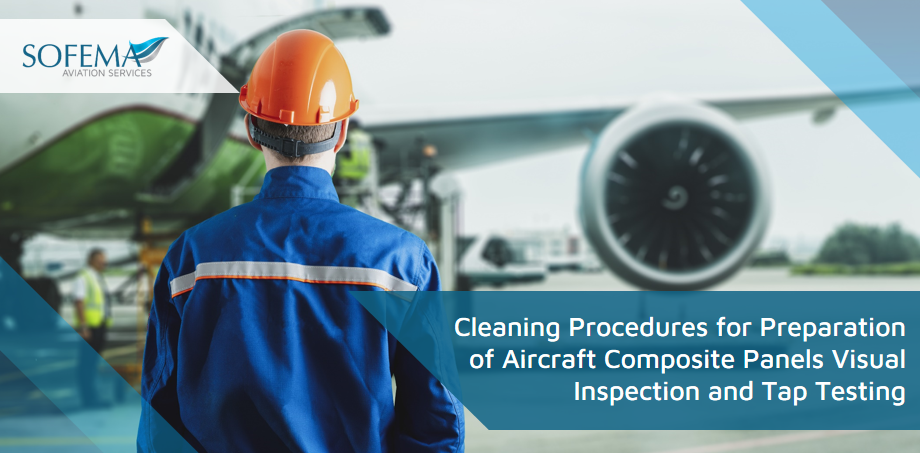Sofema Aviation Services (SAS) www.sassofia.com considers the necessary cleaning procedures employed in the preparation of aircraft composite panels prior to the visual inspection and tap testing.
Introduction – Tooling & Equipment Required
- Safety goggles
- Gloves
- Lint-free wipes or cloths
- Mild detergent or composite-approved cleaning solution:
– Examples include Methyl Ethyl Keytone (MEK) & Isopropyl Alcohol (IPA) (Always Follow Manufacturers’ Guidance) - Tap testing equipment (such as a tapping hammer)
- Flashlight & Light Source (as required)
General Notes
Throughout the inspection and testing process, maintaining cleanliness and avoid introducing new contaminants. Regularly clean the tap testing equipment between tests and ensure that the work area remains free from debris or other potential sources of contamination.
Preparation
- Ensure that the work area is well-lit and free from any clutter that may obstruct the inspection or testing process. If necessary, set up additional lighting or reflective surfaces to enhance visibility.
- Wear appropriate personal protective equipment (PPE).
- Before cleaning, visually inspect the composite surface for any visible debris, dirt, or contaminants.
- Use a flashlight to check for any surface defects, cracks, delamination, or other anomalies that may require closer inspection or tap testing.
- Loose paint should be removed with care to avoid damage to the composite surface. This may be achieved by hand sanding, e.g. using Grade 320 paper.
- Note that a primer paint of a contrasting colour may have been used to mark the surface of the structural laminate.
- Any sanding beyond the primer layer will damage the fibres and matrix.
- The manufacturer should be consulted for guidance if large areas of paint are to be stripped.
Note: Concerning Blasting, Plastic Media Blasting etc, or chemical stripping methods should be considered to be unacceptable unless specifically permitted by the manufacturer.
- Most blasting media will damage the composite outer fibre and matrix layer, whilst the constituent materials in paint stripper, e.g. Methylene Chloride, can be particularly damaging to the matrix.
Cleaning Considerations
- Cleaning may be achieved simply by wiping the surface using a cloth moistened with a suitable degreasing agent, e.g. Methyl Ethyl Keytone (MEK), Isopropyl Alcohol (IPA) etc.
– Follow the manufacturer’s guidelines for dilution ratios and application methods.
– Apply the cleaning solution to a lint-free wipe or cloth and gently wipe the composite surface in a consistent motion, avoiding excessive pressure that could potentially damage the composite material. - A clean cloth should be used for each application of agent and each removal of excess fluid and dirt respectively.
- Should a more thorough clean be required, e.g. using a mild detergent and water, then masking will be necessary to prevent further damage from cleaning agent ingress at the damage site.
– Masking should be completed using a compatible tape. - The cleaning agent should be applied with a sponge, cloth, or similar non-metallic means of application, i.e., that will not damage the surface.
- After cleaning, rinse the composite surface with clean water to remove any residue from the cleaning solution.
– Ensure thorough rinsing to avoid leaving behind any cleaning agents that could interfere with the inspection or tap testing. Once rinsed, use a clean, dry lint-free cloth to pat gently the surface dry. - The structure may be dried using a clean dry cloth. Drying can be accelerated using a clean dry compressed airflow.
– Typically this may be at temperatures up to 50C for most materials that have been cured at elevated temperatures.
– However, materials cured at room temperature (without elevated temperature post-cure) should be treated with caution at lower temperatures, e.g. 30C maximum. - All drain paths and drainage holes should be checked to ensure that they are clear of debris once cleaning has been completed.
Important Note – High-pressure hot water jets, or steam, should not be used.
Tap testing preparation
- If tap testing is required to identify any hidden defects or delamination, ensure the tapping hammer or equipment is clean and in good working condition.
- Familiarize yourself with the tap testing procedure and any specific requirements or recommendations provided by the aircraft manufacturer or maintenance manual.
Next Steps
Follow this link to our Library to find & download related documents for Free.
Sofema Aviation Services (www.sassofia.com) offers the following 2-day course – Composite Material TAP Testing for Aviation Inspectors
For comments or questions please contact team@sassofia.com
Tags:
Aircraft Cleaning, Aircraft Composite Inspection, Aircraft Composite Panels, Aircraft Maintenance, Cleaning Considerations, cleaning procedures, SAS blogs, TAP Hammer, TAP Testing




